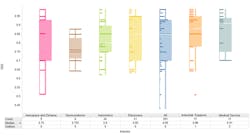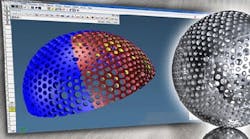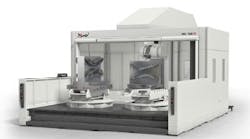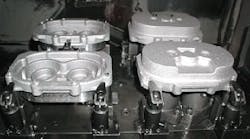Tangential milling has long been a familiar technique for speeding up flat rough and finish slab milling. In tangential milling, the inserts lie flat around the cutter’s pitch line rather than standing up radially, as in conventional cutters. This tangential orientation presents the inserts’ strongest cross section to the main cutting force so that edge life is extended and the inserts last longer. The original role for the tangential milling process was to improve tool life on big jobs such as hogging wide-area flats on large automotive castings and steel parts.
Scott Tilton, milling product manager at Ingersoll Cutting Tools (www.ingersoll-imc.com), said new cutter technology is extending the range of tangential milling. “Until recently, small-diameter tangential-milling cutters were not available that could out-perform conventional cutters because limitations in the technology of insert manufacturing did not allow for the special geometries and clearance angles necessary,” Tilton said.
“Now, with freer cutting insert geometries and smaller cutter diameters, tangential milling is emerging as a solution for faster metal removal with lower cutting forces, even on low-power machines. The wider size range of cutters also makes it a good option on small slots and cavity work as well as large-area slabbing. The only ‘must’ is that the bottom of the cut be flat,” he added.
Ingersoll has developed four-index inserts for tangential endmill cutters that are as small as 1-in. (0.25-mm) in diameter. Most indexable cutters in the 1-in. to 2-in. diameter range use two-index conventional inserts. Ingersoll’s small-tool tangential-milling inserts have an overall length of 8.5 mm and are recommended for axial depth of cuts to 5 mm.
Cutting edge life is enhanced by a special rake face geometry and a flank clearance angle that strengthens the insert when it is positioned for small diameter cutters. The inserts have a TiAlN high-aluminum coating to further enhance tool life. One of the main advantages of this cutter/insert design is the rigid steel core of the tool that remains after pockets and chip gullets are formed. Conventional inserts require deeper pocketing and chip gullet areas that penetrate deeply in the tool core. Ingersoll says its design produces a 1-in. diameter end mill that has twice the tool-core diameter of a 1-in. tool equipped with conventional inserts.
One shop that has taken advantage of the small tangential milling cutters is Riviera Tool Co. (www.riveratool.com). Riviera Tool specializes in the production of integrated, complex stamping die systems for the high speed mass production of automobile and truck body parts. Riviera Tool does its slab milling with an assortment of Ingersoll tangential milling face mill cutters — 4-in., 6-in., 8-in., and 12-in. Initially, the company used the new 1-in. diameter Smax Micro cutters to speed up machining of step-down pockets and for trim line cutting and bottom and shoulder milling in cavities. All tools in the Smax Micro family generate a 90 degree shoulder on the milled workpiece. The tools are not recommended for ramping applications.
More recently, Riviera started to use the small tangential milling cutters to machine clamp slots and open ended keyways.
Frank Upton, Riviera machine manager, said, his shop has seen a 30 percent increase in metal removal rate, on average, while doubling its tool life. The cutters are run at a speed of 2,000 rpm (624 sfm) and feedrate of 100 ipm.
Most conventional small face mills have two inserts, each with two cutting edges. The Smax Micro cutters have three inserts, each with four cutting edges.
“We have reduced our cost per cutting edge because the 1-in. Smax Micro face mills have four effective cutting edges per insert, and the tools cut smoother because the tangential design fits more inserts into the pitch circle than is possible with conventional cutters,” said Upton.
“I like tangential milling”
Over the past year, Riviera Tool has switched to tangential milling for almost all of its rough and finish slabbing work, and raised throughput more than 40 percent. Tool life rose as well, while power consumption dropped.
Riviera’s conversion to tangential milling began in early 2006 with a test. Upton was looking for a way to speed up one of his shop’s bedrock operations and to eliminate frequent tool failures. He asked Ingersoll’s Chad Meyer for suggestions.
The main obstacle to faster milling with the old tool was tool rupture, not gradual wear. “The inserts simply broke off, leaving a stump,” Upton said. He also was concerned about the high power consumption that could burn out a motor or stall the machines. “Sometimes the needle on the power meter maxed out,” he added.
The test involved Riviera’s conventional zero-rake face mills and other competitors. The trial was comprehensive, running over four weeks and including four other leading makes of face mills.
All the other candidates had conventional radial insert orientations and a variety of lead angles — 30, 45 and 90 degrees. All tests were run on identical cast iron material on the same machines, with the same operator.
The starting point of the test was Riviera’s previous standard: 25 ipm feed, 0.150 depth of cut. At the end of the test, the Ingersoll tangential cutter had optimized out at 40 ipm and 0.300-in. depth of cut, and with 30 percent longer edge life and 10 percent to 15 percent less power consumption. That was three times faster than Riviera’s previous norm for rough slabbing, and 40 percent faster than with any other cutter in the test.
Riviera does almost all of its rough and finish slab milling with an assortment of Ingersoll tangential milling cutters.
“Every time I slab a die shoe now — and we do several of them daily — I save 20 hours,” Upton said. “Tool life is up as well, and power consumption is down. The power meter that used to read 95 percent of machine capacity, or higher, now hovers nearer 80 percent. We gradually standardized on tangential milling for flat slabbing work only since early 2006, but I know we’ve already saved more than $100,000 in machining time, and I’m sure the power reduction will also help our machines last years longer.”









